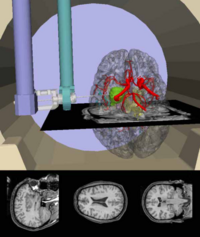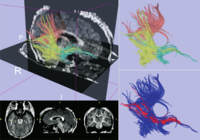HataBCDSTalk2010
Contents
Lecturer
Nobuhiko Hata, PhD (Dr. Hata's personal web page)
Associate Professor of Radiology, Harvard Medical School Director, Surgical Navigation and Robotics Laboratory (www.snrlab.org)
Speaker Bio
Nobuhiko Hata was born in Kobe, Japan. He received the B.E. degree in precision machinery engineering in 1993 from School of Engineering, The University of Tokyo, Tokyo, Japan, and the M.E. and the Doctor of Engineering degrees in precision machinery engineering in 1995 and 1998 respectively, both from Graduate School of Engineering, The University of Tokyo, Tokyo, Japan. He is currently an Associate Professor of Radiology, Harvard Medical School and Technical Director of Image Guided Therapy Program, Brigham and Women’s Hospital. He started his career at Brigham and Women’s Hospital initially as a research fellow in 1995, then became Instructor of Radiology in 2000 and Assistant Professor of Radiology in 2005, all at Department of Radiology. In 2008, He founded a research group called Surgical Navigation and Robotics Laboratory, under Image Guided Therapy Program.In the Image Guided Therapy Program and Surgical Navigation and Robotics Laboratory, he continues to work on medical image processing and robotics in image-guided surgery. His major achievements include neurosurgical navigation combined with ultrasound imaging, surgical robot for magnetic resonance imager, and motion-adaptable surgical robot for image-guided therapy. More importantly, he developed key technology in many “the first” therapy in MRI-guided therapy; MR-guided prostate biopsy, MR-guided laser ablation therapy of brain tumor, and MR-guided microwave ablation therapy of liver tumor. In total, he has co-authored 49 original articles and have been involved in 11 federal and non-federal grants during the course of his research career.
Lab date/time/location
- Oct 7, 2010, 11:45- ,
- Location TBD
Learning objective
- The participants will learn the basics and principles of medical imaging (CT, ultrasound, MRI)
- The participants will learn the utility of medical imaging in diagnostic medicine
- The learners can
Recommended reading before the class
The following papers describe a number of IMRI applications currently under development at the Surgical Planning Laboratory. Please read the paper on neurosurgery and be familiar with the other applications.
Image-guided Neurosurgery at Brigham and Women’s Hospital http://www.spl.harvard.edu/pages/Special:PubDB_View?dspaceid=294
MR-guided prostate interventions http://www.spl.harvard.edu/pages/Special:PubDB_View?dspaceid=1225
Current status and future potential of MRI-guided focused ultrasound surgery http://www.spl.harvard.edu/pages/Special:PubDB_View?dspaceid=1244
MRI-guided cryotherapy http://www.spl.harvard.edu/pages/Special:PubDB_View?dspaceid=1247
Recommended exercise before the class
- Download 3D Slicer/Install it in your computer
- Go to the down load page http://www.slicer.org/pages/Special:SlicerDownloads
- Select "stable" releases, select your OS (Windows or Mac Intel), and select the latest release
- After the downloading the installation file, click it and start an installation of the software.
- Try a tutorial on Slicer
- Go to the tutorial page http://www.slicer.org/slicerWiki/index.php/Slicer_3.6:Training
- Try the tutorial in the top two rows, namely "Slicer3Minute Tutorial" and "Slicer3Visualization Tutorial"
- [Optional] If you are comfortable using Slicer, try loading and visualizing Brain Atlas (http://www.na-mic.org/publications/item/view/1265). This will most likely be used in the lecture for demonstration.
Problems we address in the demo
- What is the patient-to-image registration? What kind of mathematical process is involved in the patient-to-image registration?
- What is Target Registration Error, Fiducial Registration Error, and Fiducial Localization error?
- What is the difference between pre-operative image guided therapy and intra-operative image guided therapy?
- What is the benefit of MRI-guided intra-operative image guided therapy?
- How would you solve the problem that intra-operative MRI has inherently less quality than pre-operative images?
- What are the main clinical applications in MRI-guided therapy?
Open questions
- What is the benefit of medical imaging for guiding and navigating surgery?
- What are the technologies involved in image guided therapy? List and briefly describe them in the order of workflow.
- From PubMed, find three interesting paper on MRI-guided therapy and summarize them. (Hint: the review papers on this topic can be found in the Feb 2008 issue of Journal Magnetic Resonance Imaging)
- What do you think is an unchallenged clinical target in MRI-guided therapy? (Hint: moving organs, soft tissue organs, tubular organs). Specify needs in the treatment and benefit of using MRI for guidance and monitoring.

